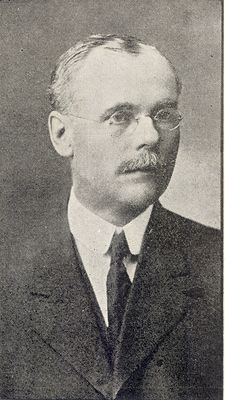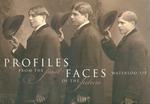John Bahnsen
In the days before John Bahnsen made his mark as the driving force behind
the renowned Globe Furniture Company of Waterloo, he was out in the cold
wilderness – chopping down trees for 75 cents a cord.
The gifted cabinet maker from Germany had immigrated to Ohio in 1884
where he met and married Helene Lorenzen. The young couple moved to Wisconsin to live with
her parents, but during the winter months there was no work for Bahnsen. “Rather than lie
around in idleness waiting for mild weather, John Bahnsen went out into the woods as a wood
chopper . . .”
In 1890, he got a job at the Manitowoc Manufacturing Company where he rose from workman to
general superintendent over all the factories of what became The American Seating Company,
headquartered in Chicago.
While Bahnsen’s star was rising in the United States, things were evolving in Waterloo’s
furniture industry. In 1906, Edward Seagram managed to get Waterloo town council to provide
incentives for the Toronto Office Specialty Company to move to Erb Street. While the furniture
business prospered here, Seagram began to look further afield, this time to Walkerville, Ontario,
where the Globe Furniture Company was based.
Together with two other prominent businessmen – Aloyes Bauer and John Letter – Seagram
bought the Globe, amalgamating it with his local furniture business to become The Globe
Furniture Company of Waterloo in 1910.
The first year of the amalgamation was a troubled one and Seagram began negotiations with
Bahnsen to bring him to Waterloo in 1911 to reorganize the factory and introduce new products
in the school and church sectors.
With Bahnsen’s expertise, the Globe Furniture Company prospered and in 1914 a modern, fourstorey brick building was erected, making the new building the largest factory in Waterloo. New
machinery was put in place and by the 1920s the company had become “one of the important
industrial institutions of Canada.”
“From all corners of Europe they pick the finest of the wood carving craft and add them to their
staff. The work when installed in churches and other public buildings throughout the Dominion
of Canada is not excelled and seldom equaled by other firms on the North American continent.”
Work done by skilled Globe artisans was placed in many prominent buildings including the
parliament buildings in London, England. Its products were installed across Canada, South
Africa and Peru making it famous for artistic wood carvings depicting scenes like the “Last
Supper.”
In 1923 Bahnsen bought a lot on Albert Street to build a home. The house, which still stands next
to the Waterloo Public Library, was designed in the Tudor Revival style by a Toronto architect
and was completed in 1924.
Bahnsen died suddenly at the age of seventy of a heart attack while visiting his daughter in
Wisconsin in 1932. His obituary read, “Mr. Bahnsen, with knowledge gained in leading furniture
plants both in United States and Canada, was recognized as one of the best executives and
designers of school and church furniture in America.”
John Bahnsen (Waterloo 150 Profile)
Description
- Creator
- Gallagher, Beth
- Media Type
- Text
- Image
- Description
- To celebrate Waterloo's 150th anniversary, the Waterloo Public Library published a book called "Profiles from the Past, Faces of the Future." This book featured 150 profiles of people who helped make Waterloo what it is today. This is the digitized profile for John Bahnsen.
- Notes
- Please visit the Waterloo Public Library to enquire about physical copies of "Profiles from the Past, Faces of the Future."
The Waterloo 150 project was funded by a grant from the Waterloo Regional Heritage Foundation. Beth Gallagher wrote the profiles with the assistance of many research volunteers. Information for the profiles was gathered from a variety of sources from the community and the Ellis Little Local History Room. Notable sources include the Ellis Little Papers, newspaper clippings, local magazines and books. - Place of Publication
- Waterloo, Ontario
- Date of Publication
- 2007
- Subject(s)
- Personal Name(s)
- Bahnsen, John ; Lorenzen, Helene ; Seagram, Edward ; Bauer, Aloyes ; Letter, John
- Corporate Name(s)
- Globe Furniture Company ; Manitowoc Manufacturing Company ; American Seating Company ; Toronto Office Specialty Company
- Language of Item
- English
- Geographic Coverage
-
-
Ontario, Canada
Latitude: 43.4668 Longitude: -80.51639
-
- Copyright Statement
- Uses other than research or private study require the permission of the rightsholder(s). Responsibility for obtaining permissions and for any use rests exclusively with the user.
- Contact
- Waterloo Public LibraryEmail:askus@wpl.ca
Website:
Agency street/mail address:35 Albert Street, Waterloo, Ontario, Canada, N2L 5E2
- Full Text




